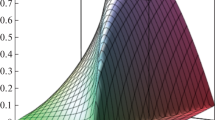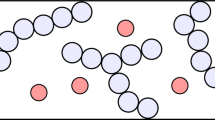Abstract
The diffusion and deformation coupled problem are considered in many material and engineering areas, and it has been studied on both theory and solution methods. However, the analytical solutions for this problem are relatively fewer, especially for two-dimensional problems. In this paper, based on a diffusion and mechanical coupled continuum model, the plane strain problem in the polar coordinates considering mass diffusion was studied. The relationship between volume strain and mass concentration was deduced by using a displacement potential function, and the analytical expression for concentration was then deduced. To comply with the mechanical boundary conditions, the Airy stress function was applied. The analytical expressions for stress components were also completely determined. After that, a numerical example of a cylinder with variant concentration distribution on its cylindrical surface was given, the results showed that concentration gradient distribution would cause the generation of stresses and the value of stresses positive correlated to the concentration gradient.






Similar content being viewed by others
REFERENCES
S. Xu and Z. Liu, “Coupled theory for transient responses of conductive hydrogels with multi-stimuli,” J. Mech. Phys. Solids 143, 104055 (2020). https://doi.org/10.1016/j.jmps.2020.104055
S. Zhang, “Chemomechanical modeling of lithiation-induced failure in high-volume-change electrode materials for lithium ion batteries,” Npj Computat. Mater. 3, 7 (2017). https://doi.org/10.1038/s41524-017-0009-z
A. T. Vuong, A.D. Rauch, and W. A. Wall, “A biochemo-mechano coupled, computational model combining membrane transport and pericellular proteolysis in tissue mechanics,” Proc. Roy. Soc. A – Math. Phys. Engi. Sci. 473 (2199) (2017). https://doi.org/10.1098/rspa.2016.0812
S. Prussin, “Generation and distribution of dislocations by solute diffusion,” J. Appl. Phys. 32, 1876-1881 (1961). https://doi.org/10.1063/1.1728256
L. Anand, “A Cahn-Hilliard-type theory for species diffusion coupled with large elastic-plastic deformations,” J. Mech. Phys. Solids 60, 1983–2002 (2012). https://doi.org/10.1016/j.jmps.2012.08.001
C. Zheng, T. Wu, and Z. Deng, “Torsion of hydrogel cylinder with a chemo-mechanical coupled nonlinear elastic theory,” Int. J. Solids Struct. 248, 111670 (2022). https://doi.org/10.1016/j.ijsolstr.2022.111670
A. Afshar and C. V. Di Leo, “A thermodynamically consistent gradient theory for diffusion–reaction–deformation in solids: Application to conversion-type electrodes,” J. Mech. Phys. Solids 151, 104368 (2021). https://doi.org/10.1016/j.jmps.2021.104368
B. Qin and Z. Zhong, “A diffusion–reaction–deformation coupling model for lithiation of silicon electrodes considering plastic flow at large deformation,” Arch. Appl. Mech. 91, 2713–2733 (2021). https://doi.org/10.1007/s00419-021-01919-z
A. F. Bower, P. R. Guduru, and V.A. Sethuraman, “A finite strain model of stress, diffusion, plastic flow, and electrochemical reactions in a lithium-ion half-cell,” J. Mech. Phys. Solids 59, 804–828 (2011). https://doi.org/10.1016/j.jmps.2011.01.003
F. Larché and J.W. Cahn, “A linear theory of thermochemical equilibrium of solids under stress,” Acta Met. 21, 1051–1063 (1973). https://doi.org/10.1016/0001-6160(73)90021-7
X. Gao, D. Fang and J. Qu, “A chemo-mechanics framework for elastic solids with surface stress,” Proc. Roy. Soc. A - Math. Phys. Eng. Sci. 471 (2015). https://doi.org/10.1098/rspa.2015.0366
X. L. Zhang and Z. Zhong, “A coupled theory for chemically active and deformable solids with mass diffusion and heat conduction,” J. Mech. Phys. Solids 107, 49–75 (2017). https://doi.org/10.1016/j.jmps.2017.06.013
X. Wang, X. Liu, and Q. Yang, “Transient analysis of diffusion-induced stress for hollow cylindrical electrode considering the end bending effect,” Acta Mech. 232, 3591–3609 (2021). https://doi.org/10.1007/s00707-021-03014-4
X.-Q. Wang and Q.-S. Yang, “An analytical solution for chemo-mechanical coupled problem in deformable sphere with mass diffusion,” Int. J. Appl. Mech. 12 (7), 2050076 (2020). https://doi.org/10.1142/s1758825120500763
K. Zhang, Y. Li, F. Wang, et al., “Stress effect on self-limiting lithiation in silicon-nanowire electrode,” Appl. Phys. Expr. 12, 045004 (2019). https://doi.org/10.7567/1882-0786/ab0ce8
M. Holzapfel, H. Buqa, W. Scheifele, et al., “A new type of nano-sized silicon/carbon composite electrode for reversible lithium insertion,” Chem. Commun., Iss. 12, 1566–1568 (2005). https://doi.org/10.1039/b417492e
J. Wang and W. Cui, “A cross-scale hygro-mechanical coupling model for hollow glass bead/resin composite materials,” Int. J. Solids Struct. 264, 112104 (2023). https://doi.org/10.1016/j.ijsolstr.2023.112104
M. Liu, “Finite element analysis of lithiation-induced decohesion of a silicon thin film adhesively bonded to a rigid substrate under potentiostatic operation,” Int. J. Solids Struct. 67–68, 263–271 (2015). https://doi.org/10.1016/j.ijsolstr.2015.04.026
X. **ao, P. Liu, M. W. Verbrugge, et al., “Improved cycling stability of silicon thin film electrodes through patterning for high energy density lithium batteries,” J. Power Sources 196, 1409–1416 (2011). https://doi.org/10.1016/j.jpowsour.2010.08.058
X.-Q. Wang and Q.-S. Yang, “A general solution for one dimensional chemo-mechanical coupled hydrogel rod,” Acta Mech. Sin. 34, 392–399 (2017). https://doi.org/10.1007/s10409-017-0728-x
Y. Suo and S. Shen, “Analytical solution for one-dimensional coupled non-Fick diffusion and mechanics,” Arch. Appl. Mech. 83, 397-411 (2012). https://doi.org/10.1007/s00419-012-0687-4
Y. Song, B. Lu, X. Ji, et al., “Diffusion induced stresses in cylindrical lithium-ion batteries: analytical solutions and design insights,” J. Electrochem. Soc. 159, A2060–A2068 (2012). https://doi.org/10.1149/2.079212jes
E. Y. Denisyuk, “Problems of the mechanics of polymer gels with unilateral constraints,” Mech. Solids 57, 292–306 (2022). https://doi.org/10.3103/S0025654422020054
Y. Zhao, P. Stein, Y. Bai, et al., “A review on modeling of electro-chemo-mechanics in lithium-ion batteries,” J. Power Sources 413, 259–283 (2019). https://doi.org/10.1016/j.jpowsour.2018.12.011
J. Chen, H. Wang, K. M. Liew, et al., “A fully coupled chemomechanical formulation with chemical reaction implemented by finite element method,” J. Appl. Mech. 86, 041006 (2019). https://doi.org/10.1115/1.4042431
Author information
Authors and Affiliations
Corresponding author
About this article
Cite this article
Yu, L., Wang, X., Chen, L. et al. Static Solutions for Plane Strain Problem of Coupled Diffusion and Deformation. Mech. Solids 58, 1768–1778 (2023). https://doi.org/10.3103/S0025654423600824
Received:
Revised:
Accepted:
Published:
Issue Date:
DOI: https://doi.org/10.3103/S0025654423600824




